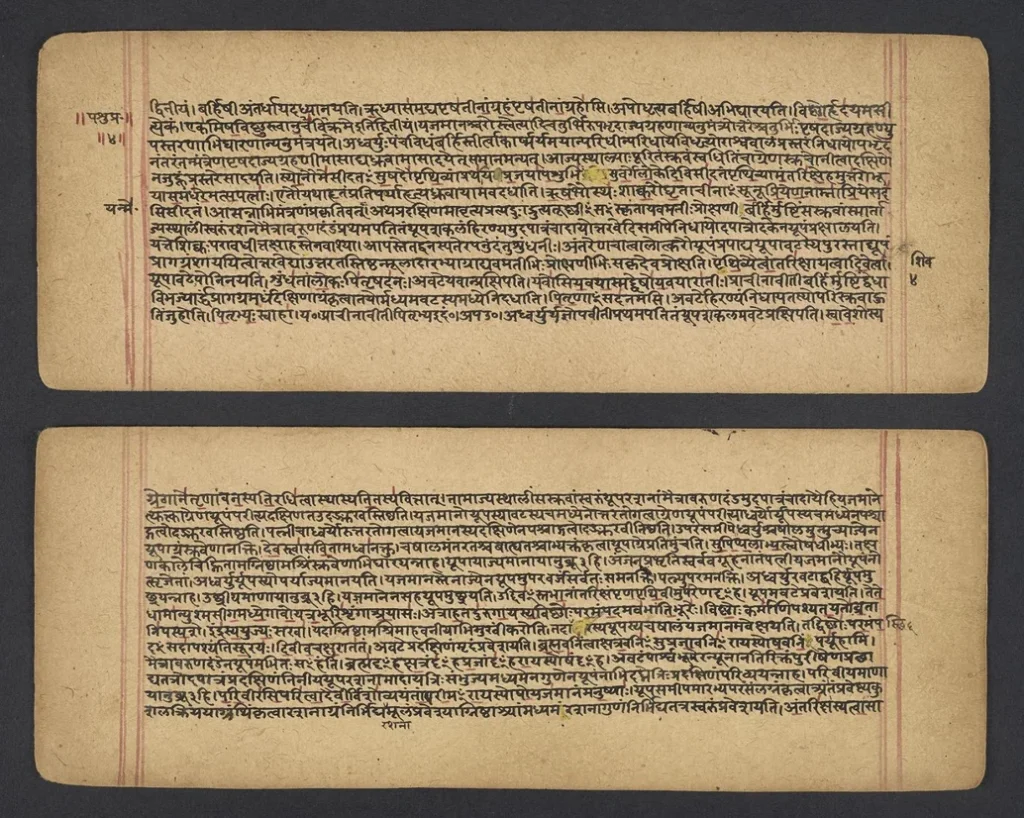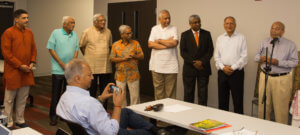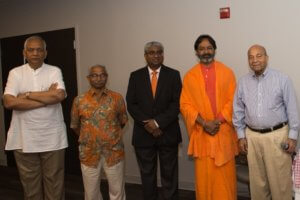
I remember, my concern a year ago was – as a 50-year-old would I be able to learn a new language at this age? I need not have worried. Samskritam has a way of staying with you
My Samskritam Journey
I had always wondered about those people who know Samskritam and can just read our ancient texts like the way most of us Indians read English books.
About eighteen months ago, by some chance I was introduced to the Hindu University of America. I started some courses here for two quarters. Then they introduced the Certificate program for Samskritam studies, and it felt like a sign. This whole covid era suddenly seemed like a blessing, because there was a lot of time saved which I could use for my coursework, and I could do these courses online from the comfort of my home. Here I was, being given an opportunity to learn Samskritam if I so chose. Earlier somehow, I used to think it was not for me, but suddenly this felt just right. This was a year ago and four quarters in, I am thoroughly enjoying the journey.
Prior to this I only knew some Samskritam chants. My mother tongue is Telugu, which uses a lot of Samskritam words with the original meaning intact. I knew the Hindi script, so that made things slightly easy at the beginning for me, although there are some differences in the way things are written in Samskritam. My reading skills were rusty, having not read much Hindi. I somehow did not have much interest in Hindi growing up, although I tremendously enjoyed learning Telugu and French.
I remember, my concern a year ago was – as a 50-year-old would I be able to learn a new language at this age? I need not have worried. Samskritam has a way of staying with you, reverberating in your mind, even when you are not studying it! I find myself mumbling sentences out in Samskritam sometimes while doing my chores. I find that I am living and breathing it as I am learning it. I start seeing or noticing what I learnt in class in my chants, the vachana, purusha, lakara (plurality, person, tense) of the verbs, the vibhakti (declensions) of the nouns, the avyayani (indeclinable/unchangeable words), and now that we are just beginning to learn sandhis, those too.
It’s not easy, let me tell you right away. One needs to put in some time and effort to learn Samskritam. But having really really good teachers like the ones I have at HUA makes a big difference. My co-students have also made a big difference for me – all of whom have chosen to learn Samskritam and are hence highly motivated. Like a saying in Samskritam
आचार्यात् पादमादत्ते पादं शिष्यः स्वमेधया । पादं सब्रह्मचारिभ्यः पादं कालक्रमेण च ॥
A quarter of the knowledge is acquired from the teacher, a quarter by the student’s own intelligence, a quarter from the co-students, and the last quarter comes with time (with practice and effort over time). These kinds of sayings helped when I was feeling impatient (to get it soon and to get it right) and hence overwhelmed in the quarters when we were beginning to learn vibhaktis – made me feel less stupid, more accepting of myself, and more patient; assuring me that everybody is in the same boat!
One of my favorite things in the Samskritam classes are the subhāṣitam – succinct, eloquent sayings, that are sprinkled all throughout the courses. My favorite are the following:
आकाशात् पतितं तोयं यथा गच्छति सागरम् । सर्वदेवनमस्कारः केशवं प्रति गच्छति ॥
It says that just as all the water that falls from the sky finds its way into the ocean, so also salutations offered to all Gods, find their way to Sriman Narayana. There is a deeper Oneness that I feel and an expansive feeling when I learn these.
अयं निजः परो वेति गणना लघुचेतसाम् । उदार चरितानां तु वसुधैव कुटुम्बकम् ॥
Meaning: The thought that this is mine and that is somebody else’s, appears only to those with a narrow-minded outlook. For the ‘large hearted’ ones, however, the entire world is One family.
सदयं हृदयं यस्य भाषितं सत्यभूषितम् । कायः परहिते यस्य कलिस्तस्य करोति किम् ॥
Meaning: One whose heart is filled with compassion, speech is adorned with truth, (and) whose constitution (form) is for the benefit of others – what can Kali (puruṣa) do to him?!
We also are being taught some stotras in a way of teaching us about samāsā (compound words). The stotras are very beautiful in general, but more so when the meaning is understood in the right light. Some of the words make me wonder whether the people who wrote these, actually experienced God in the way they describe them, if not they could not have come up with such beautiful eloquent words. तप्तकाञ्चनसन्निभम् – <body, brilliant> like molten gold or अगजाननपद्मार्कम् – <He is like> the Sun that brightens the lotus-face of the daughter of the mountain – who says such things nowadays anymore?
Through Samskritam, I am connecting deeper with our culture, samskriti, through the snippets we learn in class, whether it is the sūtras, stotras, subhaśitas, or the stories about historical figures, freedom fighters, Gods, festivals and traditions, stories from the epics, or the way the language itself is structured, it all leads back to the splendid glory that the Hindu culture was.
Did you know that the preferred voice of Samskritam is passive voice? This means that an action is done by me or through me, but I am not the do-er. This is so in line with the Hindu philosophy of simply being a channel of the action, without the ego coming into the picture, letting go of the fruits of the actions, because all action is already performed by the Higher power and the results are not in our hands. In English one might say I read the book “अहं पुस्तकं पठामि” but in Samskritam “मया पुस्तकं पठ्यते” is preferred. Coincidentally, or not, अहम् aham also is the Ego, which is left out in the कर्मणिप्रयोग karmani prayoga or passive voice.
The classes themselves are fun, light, lively and very interactive. In between lessons, we practice reading enjoyable stories from the Panchatantra, or from the SambhashanaSandesha, a Samskritam magazine. Everyone is given a chance to read the lessons or stories, if they so choose. We are encouraged to speak in Samskritam, but it’s a choice. After four quarters, I still find it daunting to speak impromptu in Samskritam. The sentences form in my mind, but when it comes to speak, I hesitate, despite knowing that I will be corrected only very gently. I admire the incredible patience of my teachers. Some mistakes are made over and over again, yet they only patiently repeat the corrections. There are many other students who speak confidently.
In the second quarter itself, we had the exciting opportunity to put together and perform a short Samskritam skit in class. I loved that project. It was optional. I was excited about it and volunteered then and there to go on first – within 4 days of the announcement. Coming up with sentences for me is easy, in the privacy of my own mind and home so confidently I did ok. Yes, there were mistakes, but there we were, like babies taking our first independent steps into the world of Samskritam, we were not chided for falling. I felt a sense of achievement and some confidence that I will be able to make it on this long journey.
We learn a lot in each class and keeping up with the classes means staying on top of things and putting in the hours to read and reread and practice writing and listening and all that good stuff. Which is why I am amazed at all my co-students, as well as my teacher, who after working a full-time job and spending time with families, have time for Samskritam classes! I truly admire all of them for their commitment.
In the third and fourth quarters, we have been introduced to our Shastras in Samskritam – the nectar of Bhagavad-Gita, Bhagavatam, Yoga-Shastras, Ayurveda-parichaya, Mukundamala (by Kulasekhara Alwar) etc. It is so exciting to learn snippets of these great texts; as I sit listening to them, I am immersed in the deepest spirituality offered by India.
Now just four quarters later, we have been prepared enough to write the entrance exam for a Master’s program in Samskritam! It will be challenging, but definitely possible. There are students who are moving in that direction. We listen to the Samskritam news, read Samskritam articles, listen to talks in Samskritam, and more recently we have a teacher who teaches purely in Samskritam, and I am pleasantly surprised that I can actually understand everything that is said. The shastras I mentioned earlier, are taught only in Samskritam.
The explanations are enunciated slowly and clearly so that we can follow them. I appreciate the amount of thought and care that went into the course planning, and the way we are being introduced to the various aspects of the language gradually.
I also learned that a simple non-assuming person called Chamu Krishna Sastry, an Indian educationist, started this new push for revival and popularizing Samskritam. His motivation inspires me. He, along with a few others, started Samskrita Bharati in 1981. He popularized “teaching Samskritam through Samskritam”. He encourages use of simple Samskritam, to gain confidence and interest. He started teaching Samskritam through spoken language rather than through the grammar which could be formidable.
It is the way babies learn to speak language and hence is easier. He encourages interesting and creative ways of teaching Samskritam, develops new vocabulary to keep up with modern science and technology. He experimented with concepts like Samskritam homes, which means that they are encouraged to speak only in Samskritam through the day. He conducts workshops, book fairs, translates books from many other languages into Samskritam, etc. Through his efforts, now Samskrita Bharati is very popular all over India and has centers in thirteen other countries, and thousands of volunteers and teachers.
He says, “Till now Sanskrit has only been seen from a spiritual or religious perspective; it is high time Sanskrit is approached from a scientific point of view as well.” You have got to listen to one of his talks in Samskritam, he is inspiring, and I guarantee if you have an Indian Mother Tongue, you will understand every word of what he says.
It is in collaboration with such an esteemed and noble organization that HUA has acquired the best teachers.
The HUA course textbooks designed by Samskrita Bharati, are in line with Samskrita Bharati’s goals. They are attractive, informative, light and easy to understand while delivering deep concepts of grammar and sentence structure in simple ways. They focus on the way children learn language through daily activities and familiar objects, and progress accordingly. I love the flow of the course material, though stories and exercises and consistency of format.
I am in Yoga in Samskritam class, my body is still, my breath is even, and my mind has no option but to focus on every single word that is being said, not because I have to, but because I want to. This is what I desire.
I am grateful to HUA and Samskrita Bharati, I feel blessed that I have this opportunity to connect with myself in this way. I am so inspired by the teachers as well as by what I am learning that now, I want to pursue a Masters in Samskritam. And if my life permits, if it is my destiny, pursue higher studies in Samskritam.
Image License : Creative Commons









